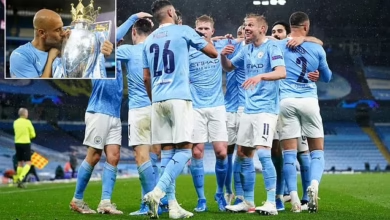Manchester City’s Summer Transfer Activity: Finley Burns Loan Move and Academy Developments

The Manchester club entered the summer with well-defined intentions, seeking to add four to five new faces to their already formidable squad. This target reflected the club’s commitment to continuous improvement and their understanding that sustained success at the highest level requires constant evolution and renewal. The Citizens’ transfer strategy has been methodical and purposeful, with each acquisition carefully considered to align with Guardiola’s tactical vision and the club’s broader sporting objectives.
Tijjani Reijnders: The Crown Jewel Addition
The signing of Tijjani Reijnders represented a significant coup for Manchester City, marking the completion of their initial transfer targets ahead of the highly anticipated FIFA Club World Cup. The Dutch midfielder’s arrival at the Etihad Stadium has been viewed as a statement of intent from the club, demonstrating their ability to attract world-class talent and their commitment to maintaining their position at the pinnacle of world football.
Reijnders brings with him a wealth of experience and technical ability that perfectly complements Guardiola’s possession-based philosophy. His versatility in midfield, combined with his exceptional passing range and tactical intelligence, makes him an ideal fit for City’s system. The timing of his arrival, just before the Club World Cup, suggests that the club views him as a crucial component of their squad for the upcoming challenges.
The acquisition of Reijnders also represents City’s continued investment in players who can contribute immediately while possessing the potential for further development. This approach has been a hallmark of the club’s transfer strategy under Guardiola, focusing on players who can adapt quickly to the demands of English football while offering long-term value to the organization.
Coaching Staff Reinforcements
Beyond player acquisitions, Manchester City have also strengthened their coaching infrastructure with the appointments of Pepijn Lijnders and James French to Guardiola’s staff. These additions represent a significant investment in the club’s coaching capabilities and demonstrate their commitment to maintaining the highest standards of preparation and tactical innovation.
Lijnders, with his extensive experience and deep understanding of modern football tactics, brings a fresh perspective to City’s coaching setup. His appointment has been particularly well-received by the players, who have reportedly embraced his methods and philosophy. The Dutch coach’s ability to work closely with Guardiola while bringing his own unique insights has created a dynamic coaching environment that benefits the entire squad.
James French’s addition to the coaching staff further reinforces City’s commitment to excellence in all aspects of player development. His expertise in specific areas of the game provides additional depth to the coaching structure, ensuring that players receive comprehensive support in their development. The positive reception from the players regarding these coaching appointments suggests that the changes have been seamlessly integrated into the club’s existing culture and methodology.
Academy Developments and Strategic Planning
Manchester City’s commitment to youth development has been evident throughout the summer transfer window, with significant activity in their academy setup. The club’s approach to youth development has always been comprehensive, focusing not only on attracting the best young talents but also on providing them with the necessary support and opportunities to reach their full potential.
The acquisition of Jeremiah Adesina represents one of the most significant recent additions to City’s academy ranks. Adesina’s arrival is part of a broader strategy to strengthen the club’s youth pipeline, ensuring a continuous flow of talented players who can potentially contribute to the first team in the future. The young player’s recruitment from Premier League rivals demonstrates City’s ability to identify and attract promising talents from across the English football landscape.
This approach of acquiring young talents from rival clubs has become increasingly common in modern football, with clubs recognizing the importance of building strong academy systems. City’s success in attracting these players speaks to their reputation for excellent youth development and their track record of providing pathways to professional football for talented youngsters.
Finley Burns: A Journey Through the Academy System
The story of Finley Burns exemplifies both the opportunities and challenges that exist within Manchester City’s academy system. The 22-year-old defender’s journey began at the age of 13 when he joined City’s academy from Southend United, marking the start of what would become a nearly decade-long association with the club.
Burns’ development through the academy ranks has been characterized by steady progress and notable achievements. His dedication to improving his game and his ability to adapt to different tactical systems have made him a valuable asset within the club’s youth setup. The defender’s technical abilities, combined with his understanding of the game, have been honed through years of working with some of the best coaches in youth football.
The highlight of Burns’ career to date came in 2021 when he made his debut for Manchester City’s first team. The occasion was a third-round EFL Cup match against Wycombe Wanderers, where City secured a comprehensive 6-1 victory. Burns’ performance in that match, where he played the entire 90 minutes, demonstrated his readiness to compete at the highest level and provided a glimpse of his potential.
That debut appearance represented more than just a personal milestone for Burns; it was validation of City’s academy system and its ability to produce players capable of contributing to the first team. The confidence shown in him by the coaching staff, particularly in allowing him to complete the full match, indicated their belief in his abilities and potential for further development.
The Loan System: A Development Strategy
Manchester City’s approach to player development has increasingly relied on strategic loan moves to provide their young talents with crucial first-team experience. Burns’ loan history exemplifies this strategy, with moves to Swansea City, Stevenage, and Hull City providing him with diverse experiences across different levels of English football.
The loan to Swansea City in 2022 represented a significant step in Burns’ development, offering him the opportunity to play regular first-team football in the Championship. The Welsh club’s style of play and their commitment to developing young players made them an ideal destination for Burns to continue his progression. His time at Swansea allowed him to experience the pressures and demands of professional football while working with experienced coaches who could help refine his game.
The subsequent loan moves to Stevenage and Hull City provided Burns with different challenges and learning opportunities. Each club offered unique tactical approaches and playing styles, allowing him to develop his versatility and adaptability as a defender. These experiences have been invaluable in shaping his understanding of the game and preparing him for the challenges of professional football.
The Hull City Setback
Burns’ most recent loan spell at Hull City during the previous season presented significant challenges that highlighted the unpredictable nature of football development. Injury problems limited the defender to just 11 appearances across all competitions, preventing him from building the momentum and consistency that are crucial for young players seeking to establish themselves in professional football.
The injury setback at Hull City was particularly frustrating given the high expectations surrounding Burns’ potential contribution to the Tigers’ campaign. The limited playing time meant that he was unable to demonstrate his full capabilities or build the kind of sustained performance level that would have enhanced his reputation and development prospects.
This experience, while disappointing, has provided Burns with valuable lessons about the physical demands of professional football and the importance of maintaining peak fitness levels. The challenges he faced at Hull City have likely contributed to his mental resilience and determination to succeed, qualities that will be essential for his future development.
The Reading Loan: A Fresh Opportunity
Manchester City’s decision to arrange a season-long loan move to Reading for the 2025/26 season represents a carefully considered step in Burns’ development journey. The League One club offers an environment where the defender can focus on regaining his fitness, building match confidence, and demonstrating his abilities consistently over a full season.
Reading’s position in League One provides Burns with an opportunity to play regular first-team football while facing a level of competition that should allow him to rebuild his confidence and form. The club’s history of developing young players and their commitment to attractive, possession-based football make them an suitable destination for a player with Burns’ technical abilities and tactical understanding.
The timing of this loan move is crucial for Burns’ career trajectory. At 22 years old, he is at a critical juncture where he needs to demonstrate his readiness for consistent first-team football. The Reading loan provides him with the platform to prove his worth and potentially attract interest from higher-level clubs or even earn reconsideration for a future role at Manchester City.
Future Prospects and Challenges
The reality facing Burns is that breaking into Manchester City’s first team has become increasingly challenging as the club has continued to strengthen their squad with world-class acquisitions. The competition for places in City’s defense is fierce, with established international players occupying the key positions and the club’s continued investment in top-tier talent making opportunities for academy graduates increasingly rare.
At 22, Burns finds himself at a crossroads where he must demonstrate exceptional ability and consistency to have any realistic chance of establishing himself in City’s first team. The club’s track record suggests that while they are committed to youth development, they are also ruthless in their pursuit of excellence, meaning that academy graduates must reach the highest standards to earn their place in the squad.
The challenge for Burns is to use his loan spell at Reading as a springboard for his career, whether that leads to a future at Manchester City or provides him with the platform to secure a permanent move to another club where he can establish himself as a regular first-team player. His development journey exemplifies the difficult balance between nurturing young talent and maintaining the highest competitive standards.
The Broader Context of City’s Transfer Strategy
Manchester City’s summer transfer activity reflects their broader strategic approach to squad building and development. The combination of high-profile signings like Reijnders, coaching staff improvements, and continued investment in academy talent demonstrates their commitment to excellence at all levels of the organization.
The club’s ability to balance immediate competitive needs with long-term development objectives has been a key factor in their sustained success. Their approach to managing young talents like Burns, providing them with loan opportunities while maintaining their connection to the club, reflects a sophisticated understanding of player development in modern football.
The 2025 summer transfer window has reinforced Manchester City’s position as one of the most ambitious and well-organized clubs in world football. Their systematic approach to improvement, combined with their commitment to developing young talent, suggests that they are well-positioned to maintain their competitive edge in the coming seasons.
Conclusion
The story of Finley Burns’ loan move to Reading represents just one element of Manchester City’s comprehensive approach to the 2025 summer transfer window. While the club has made significant strides in strengthening their first team and coaching staff, they have also remained committed to the development of their young talents through strategic loan arrangements.
Burns’ journey from academy prospect to first-team debut and through various loan experiences illustrates both the opportunities and challenges that exist within modern football’s development pathways. His upcoming season at Reading will be crucial in determining whether he can establish himself as a professional footballer at the highest level or whether his future lies elsewhere.
As Manchester City continues to evolve and strengthen their squad, the integration of academy graduates like Burns remains an important aspect of their long-term strategy. The club’s ability to balance immediate competitive demands with youth development will continue to be a defining characteristic of their approach to football excellence.














